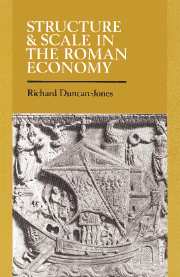Book contents
- Frontmatter
- Contents
- List of figures
- List of tables
- Preface
- List of abbreviations
- Introduction
- PART I TIME AND DISTANCE
- PART II DEMOGRAPHY AND MANPOWER
- PART III AGRARIAN PATTERNS
- PART IV THE WORLD OF CITIES
- 10 The social cost of urbanisation
- 11 Who paid for public building?
- PART V TAX-PAYMENT AND TAX-ASSESSMENT
- Appendices
- Bibliography
- Index
11 - Who paid for public building?
Published online by Cambridge University Press: 13 October 2009
- Frontmatter
- Contents
- List of figures
- List of tables
- Preface
- List of abbreviations
- Introduction
- PART I TIME AND DISTANCE
- PART II DEMOGRAPHY AND MANPOWER
- PART III AGRARIAN PATTERNS
- PART IV THE WORLD OF CITIES
- 10 The social cost of urbanisation
- 11 Who paid for public building?
- PART V TAX-PAYMENT AND TAX-ASSESSMENT
- Appendices
- Bibliography
- Index
Summary
The aim here is to ask how the civic burdens discussed in the previous chapter were distributed, and to look at the dividing–line between what came from town funds and what was directly paid for by the individual. Two African towns, Thugga and Thamugadi, are taken as test cases (Thugga is considered from a different perspective in chapter 4). Evidence from other towns in Africa is considered in a short further analysis (Table 48).
Direct labour
Cicero writes of the ancient Capitol at Rome as having been built for nothing, because it was built with forced labour. Livy says that the Capitol was built with a mixture of forced labour and public funds. Forced labour on public works continues to figure to some extent in Rome's later history, where there is better documentation. One of the more severe legal punishments was damnatio ad opus publicum, being condemned to labour on public works. When the younger Pliny was governing Bithynia under Trajan, he found that the largest cities contained many men who had been condemned ad opus publicum, but who had managed to escape. Instead of working on buildings, they had found alternative employment in the city as public slaves. When told of this, Trajan ruled that they must go back to their original punishment, unless condemned more than ten years previously. Trajan laid down that they must work on servicing public baths, cleaning sewers and building roads and streets.
- Type
- Chapter
- Information
- Structure and Scale in the Roman Economy , pp. 174 - 184Publisher: Cambridge University PressPrint publication year: 1990
- 2
- Cited by



